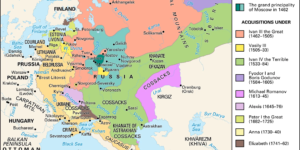Why Trump’s Racist And Neo-Fascist Campaign Strategy Resonates In 21st Century America
1 CommentWith the November election just around the corner, Donald Trump is raising the level of his racist and fascist rhetoric to new heights, fully aware that his hate speech and authoritarian overtures resonate with a large segment of white Americans in 21st century who, as surreal and obscene as this may sound, would have preferred that time stood still, stuck either in the era of the plantation system or at least at a time when whites in this country felt so superior to minorities that they could discriminate and oppress the “Other” without fear of getting into trouble with the law, let alone become witness to public outcries over police brutality, systemic racism, and demands for gender and racial equality.
Indeed, it is the awareness of the existence of a very large segment of white Americans in 21 st century who wish to roll back the clock on account of their growing insecurities and fears about the[ir] future that prompts Trump to sound ever more racist and project ever more the image of a strong man as time moves closer to election time. In doing so, his hope is that even moderate white voters might be stirred into feeling the need to join in on what he obviously hopes they may come to recognize and appreciate, just like his traditional base of white supremacists does, as an urgent “patriotic” campaign on the part of the “Great White Leader” to save [white] America’s soul. As for his rich supporters, he doesn’t care one way or another about the impact of his rhetoric on them because he knows they will continue supporting him as long as he maintains a steadfast course of lavishing them with gifts, such as huge tax cuts, deregulation policies, etc.
Trump’s attempt to outdo himself was most evident at his Minnesota rally a few days ago– perhaps the most extreme example so far of how far the “Great White Leader” is ready and willing to go in order to spread fear and promote hate as tactical means of securing another electoral victory in a country sharply divided into different political tribes.
And make no mistake about it: reliance on fear, hate, and violence have always been the political tools of fascists of all stripes.
Trump declared to Minnesotans that Biden would turn their state into a “refugee camp.” He warned them of “sleepy Joe Biden’s extreme plan to flood” Minnesota with refugees from Somalia, while denigrating at the same time the election of Rep. Ilhan Omar, who came to the United States as a child refugee from Somalia, calling her an “extremist”. To this insidious racist rhetoric, his fanatical base from below responded by screaming “send her back.”
Trump’s racist rhetoric hit a crescendo when he let his crowd know that they are supporting him because of their “good genes.”And to further upgrade his neo-fascist profile with his adoring crowd, he said it was “a beautiful thing” when journalist Ali Velshi got struck by a rubber bullet while covering a peaceful protest.
All in all, Trump’s performance at the Minnesota rally on September 18 was an act stolen from the electoral campaign of Hitler and his Nazi party. The only thing he fell short from saying was that anyone who did not support him should be deprived of civic rights and sent to prison or concentration camps.
No rational human being can fail to see that Trump is a racist with strong fascist impulses, but even critics of Trump fail to see or properly acknowledge that the “Great White Leader” employs the rhetoric of racism and fascism because there is a huge market for it in 21 st century America!
As such, it is a big mistake to think that what the United States is experiencing in the age of Trump is an “aberration.” Trump’s rise to power is the culmination of the long history of racism, violence, and extreme nationalism in US society. To argue otherwise would compel one to see the Cold War and the establishment of a war economy in the aftermath of the Second World War also as “aberrations” in the historical evolution of the US political culture; or the phenomenon of McCarthyism from the late 1940s to the mid-1950s; or the genocidal campaign against the Vietnamese people; or the assassinations of Martin Luther King Jr., and of Malcolm in the 1960s.
Unfortunately, these episodes were no more “aberrations” in the evolution of US political culture than is the US love affair with guns. Although the military strategy changed, scores of massively destructive wars followed the Vietnam debacle, and systemic racism (the assumption of white superiority on both individual and institutional levels) continued to operate all over society, with the law enforcement community and the judicial system acting often enough as keepers of racial hierarchy.
The recent blows dealt to an already highly flawed system of democratic governance (the US is the only democracy in the world where the principle of the one person-one vote rule does not count, and where money is usually the determinant factor in the outcome of elections) by the various institutions of the US political system, including the Supreme Court (think of Citizens United v. Federal Election Commission and Shelby County v. Holder) ) and the resurgence of voter suppression are also not “aberrations” in the evolution of the US political culture.
And lest we forget, Donald Trump’s “law and order” politics dates all the way back to slavery and Jim Crow, and virtually every postwar Republican president before Trump harped on “law and order” in campaign speeches.
Of course, that’s one face of the United States – i.e., a country with a deep and profound racist and violent culture, one that, incidentally, has been at war 225 out of 243 years since 1776.
The other face of the United States is one of constant struggle among decent and courageous people aiming to move the country in the direction of peace and justice.
Undoubtedly, the history of the United States is at one and the same time of social struggles, resistance, and resiliency. From the Stono Rebellion of 1739 to Shays’ Rebellion in1786, and from the May 1, 1886 industrial workers’ strike to the Black Lives Movement of today, US political history is filled with chapters of heroic and noble struggles against the kind of social order envisaged by Trump and his supporters.
Virtually at every juncture in the evolution of a racist and oppressive system, down to this day, there were brave souls standing up to it and challenging it — a Frederick August Washington Douglas (aka Frederick Douglass), a Harriett Tubman, a Paul Robeson, an Angela Davis, a Howard Zinn, and a Noam Chomsky, along with millions of unknown activists.
But the critical question that remains to be answered is this: why do political Neanderthals and other “nice people” (racists, sexists, homophobes, anti-science, religious fundamentalists and climate change denialists) abound in the world’s richest and most powerful nation in the world, thereby allowing someone with the political instincts of Donald Trump to destroy democracy and potentially civilized life on planet earth with his anti-environmental and nuclear policies, respectively?
Let’s be clear about this, and have no illusions to the contrary. Trump did not create his fanatical base, especially in rural America. It was already there when he stepped into the political spotlight. He merely exploited it, quite brilliantly, by tapping into the psyche of its members, appealing to their subconscious emotions (fear, hate, anger, frustration) and provincial mentality. In this context, he succeeded in drawing political support from the sort of people that Trump himself wouldn’t be caught dead being in their midst.
Indeed, few demagogues in the course of history can lay claim to such a masterful political achievement.
The economic policies of neoliberalism of the past forty or so years, coupled with the presence of a traditionally weak developmental state, lie at the heart of any attempt to explain why political divisions in the US, which, incidentally, have been present from the very origins of the early republic (think, for example, of the ferocious conflict between Federalists and Anti-Federalists, or the animosity between the political camps represented by Thomas Jefferson and John Adams, respectively), have turned over the last twenty or so years into sharp political polarization that is literally tearing the country apart. But it’s not enough to make real sense of the ongoing political polarization.
As in pretty much the rest of the world, neoliberalism intensified existing economic inequalities in the United States by creating tremendous gaps between the haves and the have-nots through the destruction of the country’s industrial base and the failure of wages to grow for average workers, while shifting wealth at the same time not only from the poor to the rich but also from those who produce new goods and services to those who control existing assets. In other words, under neoliberalism and the ensuing financialization of the economy, the balance of power in the ever present, sometimes overt, sometimes covert class struggle of a capitalist economy shifted overwhelmingly toward the side of financial capital. Labor and productive capital ended up both on the losing side.
Growing economic inequalities, job insecurity, and declining standards of living led in due time to growing levels of frustration and discontent among America’s white working-class. In their minds, the American dream was becoming a thing of the past, especially as manufacturing jobs were going overseas in pursuit of cheap labor. The elites, as far as they were concerned, had taken over the government and the economy, a view which seems to have gained much currency following the bailouts of banks and Wall Street in the aftermath of the financial crisis of 2007-08, while millions of homeowners lost their homes.
In a very perverted sense, the elite theory of US democracy, which used to be at the heart of the radical interpretation of the way the domestic political system functions from the moment that C. Wright Mills had conceived it, seems to have captured the imagination of many average citizens in recent times, absent of course the intellectual nuisances regarding the workings of a capitalist economy and the complex relationship between economics and politics. To be sure, the formation of a view of elite dominance in contemporary US society and economy was materialized primarily, if not exclusively, through conspiratorial thinking.
Rural communities, always lagging behind urban communities, and with social and cultural settings still not very different from those that Alexis Tocqueville had witnessed during his visit to the United States in 1832 (he was struck by the absence of science and the country’s intense religiosity, along with the presence of a deeply rooted culture of individualism), grew especially disdain of “big government.” academic elites, science and media alike, and far more prone therefore to embrace the extremist rhetoric of someone like Donald Trump.
Of course, rural America was always conservative, but the shift towards the GOP has intensified over the past decade not merely because of political and economic reasons, but, perhaps more important, because of cultural reasons. It is true that the economic agenda of the Democratic party is seen by most rural Americans, who are primarily home owners and self-employed, as being against their interests. They hate “big government” because they associate it with corruption and high taxes used to fund a welfare state which they think is there in order to give out handouts to lazy and unworthy people, mostly blacks and immigrants. But, aided by the deliberative and systematic attempts of conservative media to spread views intent on serving a highly reactionary political agenda (“patriotism”, “god”, and “guns”), rural America has also turning increasingly Red because of its aversion to what it perceives to be the cosmopolitan, multicultural, and even anti-American leanings of the liberal establishment, and of course because of fear that liberals will take away from decent folks their “sacred right” to have access to guns.
The anti-immigrant and an-elite sentiments expressed by Trump in his 2016 electoral campaign were crucial to his winning the rural vote, but there is plenty of evidence (see Identity Crisis by John Sides, Michael Tesler, and Lynn Vavreck) to indicate that the anti-immigrant sentiment was the more critical factor, which is why the “Great White Leader” is doubling down on the anti-immigrant rhetoric in his re-election campaign.
In a nutshell, the political divides between rural and urban America are much more deeply cultural than they are economic. And this cultural divide isn’t only being masterfully exploited by Donald Trump through his racist and fascist rhetoric, but is highly unlikely to close in the near future. In fact, the more the rest of the country changes, the more likely it is that white conservative voters will keep digging deeper into the power of nostalgia, reminiscent of the time when America was still great because white superiority was in their view unchallenged and everybody else knew their station in life.
Moreover, given the fact that the electoral system favors disproportionally the rural vote, however sparsely populated the urban regions may be, the future of the GOP may very well lie with the continuation of political extremism masterminded by the “Great White Leader” himself. In fact, we may very well get a taste of the permanent damage caused by Trump’s rise to power, even if he loses the November election, in the event that the next Supreme Court Justice is nominated before the election.
Either way, the struggle to eradicate systemic racism, overcome gross inequalities, and change the course of the country towards the direction of peace, social justice and a sustainable future has a long way to go in 21st century America. At least half of the country is clearly moving forward, while a good chunk of it wants to return to a “golden era” of white supremacy and outdated social values and cultural norms, perceptions and sentiments which provide ample ground for the flourishing of ideas that feed the racist and neo-fascist beast associated with the politics of Donald Trump.
In this context, the major task for progressives, regardless of whether it is Trump or Biden in the White House in 2021, is to search for creative ways that will alter public consciousness in the United States about the devastating effects of a political culture engulfed in the flames of racial strife, violence, militarism, and climate change denialism. The mission is as much cultural and educational as it is political.
You May Also Like
Comments
One Response to “Why Trump’s Racist And Neo-Fascist Campaign Strategy Resonates In 21st Century America”
Leave a Reply










September 23rd, 2020 @ 1:54 pm
Powerful analysis on a most disturbing development, but, then again, as the author brilliantly highlights, the United States was never a “normal” country.